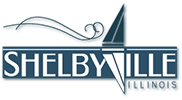The Shelbyville Chautauqua Auditorium
A Historical and Architectural Icon
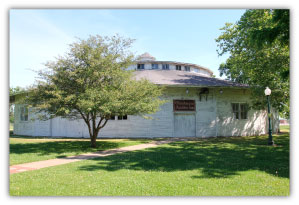 The Chautauqua Auditorium, built in 1903, is a large historic icosagonal (20-sided) wooden Chautauqua meeting hall located in the center of Forest Park on North East 9th Street.
The Chautauqua Auditorium, built in 1903, is a large historic icosagonal (20-sided) wooden Chautauqua meeting hall located in the center of Forest Park on North East 9th Street.
Highly popular in the late 19th and early 20th centuries, Chautauqua was an adult education movement in the United States. Chautauqua assemblies broadened and spread throughout rural America until the mid-1920s. The Chautauqua brought entertainment and culture for the whole neighborhood, with instructors, teachers, speakers, musicians, preachers and performers of the day.
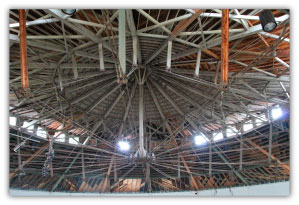 Organized in 1874, the first Chautauqua, the New York City Chautauqua Assembly, was established at a campsite on the coasts of Chautauqua Lake in New York State. Later becoming known ad the Chautauqua Organization, it was originally called the “Mother Chautauqua”, because numerous independent, or “Daughter” Chautauquas were established under the same fashion.
Organized in 1874, the first Chautauqua, the New York City Chautauqua Assembly, was established at a campsite on the coasts of Chautauqua Lake in New York State. Later becoming known ad the Chautauqua Organization, it was originally called the “Mother Chautauqua”, because numerous independent, or “Daughter” Chautauquas were established under the same fashion.
At the height of the Chautauqua movement in the 1920s, a number of hundred of these existed, but their numbers are decreasing. Independent Chautauqua were normally built in an attractive semi-rural location a brief distance outside an established town with good rail service.
Established in 1901, the Shelbyville Chautauqua Association was developed and the following year, the Association voted to construct a permanent structure just as many other Chautauqua hosting areas had done. It was clear that in the early 1900’s, the Chautauqua Auditorium was the center for hometown entertainment and social events for Shelbyville and its bordering communities.
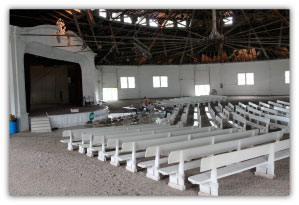 The Chautauqua Auditorium was based on a similar structure built in Dixon, Illinois and designed by Architect Morrison H, Vail. The project took eight months to build at a cost of approximately $7,500.
The Chautauqua Auditorium was based on a similar structure built in Dixon, Illinois and designed by Architect Morrison H, Vail. The project took eight months to build at a cost of approximately $7,500.
The aesthetic of the structure was intended to resemble big outdoor tents, which display the early beginnings of the Chautauqua movement. The structure features a series of 40 operable clerestory windows, 18 large windows located on the main floor level and ten big upright overhead doors. The framework is made up of twenty trusses built from multi-ply wood top chords, double steel tie-rod bottom chords and strong timber web construction materials. The trusses bear upon timber columns located at each end of the walls that comprise the twenty-sided framework. Each column is supported on foundations of 4′ x 4′ flared concrete footings and is anchored to the footings by wrought iron anchors. The lateral support for the structure is comprised of 2×6 shear walls and horizontal tongue and groove plank home siding. The interior floor area of the building is 15,000 square feet and the roof is supported by an unique series of beams and supports in the ceiling. The clear span of the framework is 150 feet, which means there are no columns anywhere in the building to obstruct the view of the stage.
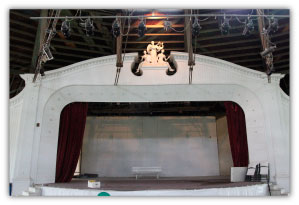 The building also has a huge 36’x36′ stage featuring Grecian statues by local artist Robert Root that sit atop the stage representing Art, Music and Drama. The Auditorium also had an orchestra pit at one time that could seat up to twenty musicians. The seating is arranged in a bowl-shape similar to many modern day auditoriums.
The building also has a huge 36’x36′ stage featuring Grecian statues by local artist Robert Root that sit atop the stage representing Art, Music and Drama. The Auditorium also had an orchestra pit at one time that could seat up to twenty musicians. The seating is arranged in a bowl-shape similar to many modern day auditoriums.
The Shelbyville Chautauqua was one of many independent Chautauquas across the country. Even so, it has been a stop for many famous speakers including William Howard Taft, William Jennings Bryan, Billy Sunday, Reverend Sam Jones, and Carry Nation among others. Other past performers at the Chautauqua Auditorium include Dolly Parton, Alison Krauss, REO Speedwagon and Barbara Mandrell.
It has been used for many local entertainment purposes purposes in recent years, including music concerts, talent shows, meetings, haunted houses, weddings and serves as the centerpiece for the Festival of Lights during the Christmas Season.
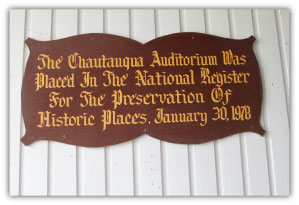 On January 30, 1978, it was added to the National Register of Historic Places and in 2009, Landmarks Illinois declared it one of the 10 most endangered historic places in Illinois.
On January 30, 1978, it was added to the National Register of Historic Places and in 2009, Landmarks Illinois declared it one of the 10 most endangered historic places in Illinois.
The Chautauqua Auditorium is no doubt a magnificent building, but has suffered through many years of weather, deterioration and neglect. Much of the original structure is still in tact and performing well. The building is in need of extensive repairs which are estimated to cost $1.75 million and to be completed in a four-phase restoration project. The city of Shelbyville which owns the auditorium and is currently working closely with the Chautauqua Auditorium Preservation Committee to find ways to bring the building back to shape.
The building is currently maintained by the Shelbyville parks and grounds crews.
The Shelbyville, Illinois Chautauqua: A Cultural and Historical Legacy
Introduction
The Chautauqua movement, originating in the late 19th century, was an educational and cultural phenomenon that brought learning, arts, and entertainment to rural communities across the United States. While its roots trace back to a campsite in New York, the movement quickly spread to other regions, including the Midwest, where it found a particularly fertile ground. Among the many Chautauquas that blossomed across America, the Shelbyville Chautauqua in Illinois stands out as a significant cultural landmark, embodying the spirit of the movement and leaving an indelible mark on the local community.
This article delves into the history of the Shelbyville Chautauqua, exploring its origins, its golden age, the challenges it faced, and the legacy it left behind. It also highlights the architectural significance of the Chautauqua Auditorium, a National Historic Landmark, and the ongoing efforts to preserve this piece of cultural history.
I. The Origins of the Chautauqua Movement
A. Beginnings in New York
The Chautauqua movement began in 1874, with the establishment of the Chautauqua Institution on the shores of Chautauqua Lake in New York by John Heyl Vincent, a Methodist minister, and Lewis Miller, an industrialist. Originally intended as a summer training program for Sunday school teachers, the movement quickly expanded its scope to include a wide range of educational and cultural activities. This “Mother Chautauqua” became the template for numerous “Daughter Chautauquas” that would spring up across the United States.
B. Expansion into the Midwest
The Chautauqua movement found a particularly receptive audience in the Midwest, where the combination of rural isolation and a hunger for cultural enrichment created a perfect environment for its growth. Chautauquas became known as “the most American thing in America,” offering lectures, musical performances, religious services, and a variety of other educational programs. These events were often held in picturesque rural settings, providing a respite from the daily grind and an opportunity for intellectual and spiritual renewal.
II. Shelbyville: A Town Ready for Cultural Enrichment
A. Historical Background of Shelbyville, Illinois
Founded in the early 19th century, Shelbyville, Illinois, was a typical Midwestern town with a strong agricultural base. By the turn of the century, the town was looking for ways to enhance the cultural and intellectual life of its citizens. The Chautauqua movement, with its promise of education, entertainment, and moral uplift, was seen as an ideal way to meet this need.
B. The Arrival of the Chautauqua in Shelbyville
In 1901, the Shelbyville Chautauqua Association was formed with the goal of bringing the Chautauqua experience to the town. The following year, the Association voted to construct a permanent structure to host Chautauqua events, a decision that would lead to the creation of one of the most iconic buildings in the region: the Shelbyville Chautauqua Auditorium.
III. The Golden Age of the Shelbyville Chautauqua
A. Early Years and Growth
The Shelbyville Chautauqua quickly became a popular destination for both residents and visitors. The early years were marked by a diverse array of programming, including lectures on current events, musical performances, religious services, and even political debates. The Chautauqua was not just a place for entertainment; it was a forum for the exchange of ideas and a catalyst for social change.
B. Cultural and Educational Impact
The Chautauqua brought some of the most prominent speakers and performers of the day to Shelbyville. Notable figures who graced the stage of the Shelbyville Chautauqua included former President William Howard Taft, politician William Jennings Bryan, evangelist Billy Sunday, and temperance advocate Carry Nation. These events had a profound impact on the community, fostering a sense of civic pride and a commitment to lifelong learning.
C. Infrastructure and Economy
The construction of the Chautauqua Auditorium in 1903 was a significant event in the history of Shelbyville. Designed by architect Morrison H. Vail and inspired by a similar structure in Dixon, Illinois, the Auditorium was an architectural marvel. Its unique icosagonal (20-sided) design, with a clear-span roof supported by an intricate system of wooden trusses, allowed for unobstructed views of the stage from any seat in the house. The Auditorium quickly became the focal point of cultural life in Shelbyville, hosting not only Chautauqua events but also a variety of other community gatherings.
IV. Challenges and Decline
A. Changing Times
The popularity of the Chautauqua movement began to wane in the 1920s, as new forms of entertainment, such as radio and motion pictures, emerged. The Shelbyville Chautauqua was not immune to these trends, and attendance began to decline. The economic hardships of the Great Depression further exacerbated the situation, making it increasingly difficult to sustain the Chautauqua financially.
B. Local Challenges
In addition to these broader societal changes, the Shelbyville Chautauqua faced a number of local challenges. The cost of maintaining the Auditorium, coupled with declining revenues, put a strain on the Chautauqua Association. Despite the efforts of community leaders to revitalize the Chautauqua, the once-thriving institution began to fade into obscurity.
C. The Final Years
The last official Chautauqua event in Shelbyville was held in the early 1930s. In the years that followed, the Auditorium was used for a variety of other purposes, including concerts, talent shows, and community meetings. However, the glory days of the Shelbyville Chautauqua were over, and the building slowly fell into disrepair.
V. Legacy and Remembrance
A. The Shelbyville Chautauqua’s Long-Term Impact
Despite its decline, the Shelbyville Chautauqua left a lasting legacy in the community. The values of education, culture, and civic engagement that were at the heart of the Chautauqua movement continued to resonate in Shelbyville long after the Chautauqua itself had ceased to exist. The Auditorium, in particular, remained a symbol of the town’s cultural heritage.
B. Preservation and Commemoration
In recognition of its historical and architectural significance, the Shelbyville Chautauqua Auditorium was added to the National Register of Historic Places in 1978. However, the building continued to suffer from neglect and weather-related damage. In 2009, it was listed by Landmarks Illinois as one of the 10 most endangered historic places in the state. This designation sparked renewed efforts to preserve the Auditorium, leading to a multi-phase restoration project aimed at bringing the building back to its former glory.
The restoration project, estimated to cost $1.75 million, has been a collaborative effort between the city of Shelbyville, the Chautauqua Auditorium Preservation Committee, and local volunteers. The goal is not only to preserve the physical structure but also to revive the spirit of the Chautauqua by once again making the Auditorium a center for community life.
C. Lessons from the Shelbyville Chautauqua
The story of the Shelbyville Chautauqua is a reminder of the importance of cultural institutions in shaping the identity and values of a community. While the Chautauqua movement may have faded from the national stage, its legacy lives on in places like Shelbyville, where the Auditorium stands as a testament to a bygone era of civic engagement and cultural enrichment.
Conclusion
The Shelbyville Chautauqua was more than just a series of lectures and performances; it was a cultural phenomenon that brought a sense of purpose and community to the people of Shelbyville and beyond. The Chautauqua Auditorium, with its unique architecture and rich history, continues to serve as a symbol of that legacy. As efforts to restore and preserve the Auditorium continue, the people of Shelbyville are not just preserving a building—they are keeping alive the spirit of the Chautauqua, ensuring that future generations can experience the cultural and educational benefits that it once provided.
References
https://en.wikipedia.org/wiki/Chautauqua_Auditorium_(Shelbyville,_Illinois)
https://www.enjoyillinois.com/explore/listing/chautauqua-auditorium/
